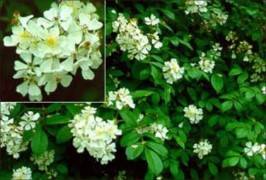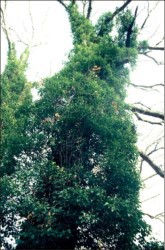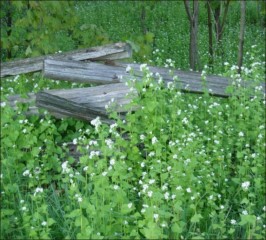Novi Woody Invasive Species RemovalsNovi has been actively working to remove trees and shrubs that have taken over some of our parks. These are known as alien invasive woody plants, which simply means that they are tree or shrub species that originated in other areas of the country or world and came to Michigan intentionally or accidentally. They are considered invasive if they reproduce and spread to the extent that they have a significant negative impact on the natural habitat. |
Canada Geese
Coyotes
Injured or Abandoned Wildlife Resources
Miscellaneous Resources
Canada Geese
Canada geese numbers throughout Michigan have increased substantially from a population of about 9,000 in 1970, to an estimated population of more than 300,000 today. Canada geese are very adaptable, especially to urban and suburban habitats, and with the changing weather, increased development along their migratory route, and changing farming patterns, many Canada geese no longer migrate to traditional wintering grounds in the southern United States and Mexico. Home has become the parks, golf courses and suburban sub-developments across the area.
Impact on Novi
Complaints of geese in Novi are a frequent occurrence. In addition to Pavilion Shore Park, we also see them at Fuerst Park, ITC Sports Park and Ella Mae Power Park. They are basically found anywhere with open lawn for and access to water.
DNR Resident Canada Goose Management FAQs
Parks Maintenance Efforts

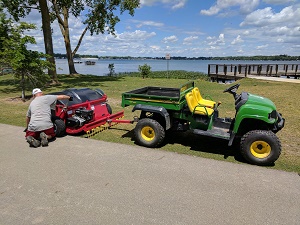
The Novi Parks Maintenance team works tirelessly to keep our parks clean. In addition to power washing the walkways, pavilions and patio areas on a daily basis during the spring and summer, the team also invested in a “Goose Sweep” machine to remove droppings from the grassy areas. The machine is used weekly to clean up the parks and has proven effective in removing the waste. As far as we are aware, we are the only local community in the area that owns one of these machines. Barrier fencing has also been installed at Pavilion Shore Park to keep the geese from entering and exiting the water in the area, however, it is not effective in deterring them from flying into other areas of the park.
Nest destruction
The City has yet to find a nest or receive reports of a nest on City property. Nest and egg destruction programs on private property have been the responsibility of local homeowner associations and/or individual residents. For example, Liberty Park received City Council approval in April 2018 to use a contractor for their nest/egg destruction program.
Dogs and other deterrents
The use of dogs, noisemakers and other deterrents have proven not to be effective. They are temporary measures at best and are not a long term solution. Ultimately, deterring or chasing off a flock is only temporary until the next one flies in.
Roundups
The Michigan Department of Natural Resources has a list of Frequently Asked Questions that can be found here. They do not feel roundup is an effective long-term solution for addressing Canada geese conflicts and note it has limited success reducing the number of geese complaints. We have not considered this option as it is not recommended based on the DNR’s information.
Reducing the population
Decisions on expanding the Canada Geese hunting season or other practices to manage the population fall under the DNR’s Wildlife Division. Information on the Wildlife Division can be found here:
Novi’s Plan of Action
Due to the ineffectiveness of roundups, dogs and other deterrents, the City will continue its current maintenance practices while monitoring the DNR’s efforts and following their recommendations. We will continue to monitor new deterrent products as they come on the market, however, recent products such as chemicals, lasers and drones have also proven ineffective as a long term solution. Unfortunately, our best option at this time is continual maintenance. We also will continue to encourage our residents to not feed the birds as that entices them to come back.
Coyotes
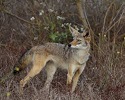 Coyote numbers are growing in Southeast Michigan. There is currently no definitive statistic on the coyote population in Southeast Michigan. What scientists do know is coyotes do not attack people and less than 1% of coyotes become nuisances. It is in the best interest of both coyotes and humans if coyotes retain their instinctive fear of people. Coyotes that are fed become accustom to people and present a human safety risk. DO NOT feed coyotes. The Novi Department of Public Safety would like to offer some helpful hints in the unlikely event you have an encounter with a coyote.
Coyote numbers are growing in Southeast Michigan. There is currently no definitive statistic on the coyote population in Southeast Michigan. What scientists do know is coyotes do not attack people and less than 1% of coyotes become nuisances. It is in the best interest of both coyotes and humans if coyotes retain their instinctive fear of people. Coyotes that are fed become accustom to people and present a human safety risk. DO NOT feed coyotes. The Novi Department of Public Safety would like to offer some helpful hints in the unlikely event you have an encounter with a coyote.
Living with Coyotes
- Never feed coyotes, fence off gardens and fruit trees.
- Coyotes are more active at sunset and sunrise.
- Keep small pets inside at nights.
- Cover garbage, clear out wood and brush piles.
- Do not leave dog or cat food or water outside overnight.
- Make sure bird feeders are not accessible and never toss food scraps on the ground.
- When walking dogs at sunrise or sunset, keep them on a leash, accompany pets outdoors and do not allow them to roam free in unfenced yards.
- If you see a coyote around your home; shout, create noise, and make commotion to scare them away.
- Become knowledgeable, not fearful.
What Should I Do
- Never approach or touch a coyote
- Observe from a distance
- Do not run from an aggressive coyote; if followed by a coyote, shout or throw something in its direction.
- Do not feed coyotes
- Eliminate outside food sources
![]() Decoding Coyote Tip Sheet
Decoding Coyote Tip Sheet![]() Michigan Coyote Facts
Michigan Coyote Facts
Knowledge and an informed perspective can help humans and coyotes co-exist.
Injured or Abandoned Wildlife Resources
- Wildlife Acres Rehabilitation 248-627-9615
- Michigan Department of Natural Resources
- Oakland County Animal Control 248-858-1090 or 248-391-4102
- Novi Police Department 248-348-7100
Invasive Species
Like much of Michigan and the entire United States, the City of Novi has many invasive plant species that have crept their way into our lives. An invasive plant species is any species that has been introduced into an ecosystem to which the species is not indigenous and which has a tendency to spread rapidly. Introduction is sometimes accidental, but often is initiated by humans intentionally importing the plant to an area normally beyond its natural growing range. Invasive plants often cause harm to environmental, economic or human wellbeing. While many invasive plant species have been introduced from outside the United States, there are also many species within the U.S. that have become invasive due to their introduction or spread to distant areas within our own borders.
According to the United States National Arboretum, “An invasive plant has the ability to thrive and spread aggressively outside its natural range.” A naturally aggressive plant may be especially invasive when it is introduced to a new habitat. An invasive species that colonizes a new area may gain an ecological edge since the insects, diseases, and foraging animals that naturally keep its growth in check in its native range are not present in its new habitat.
Some invasive plants are worse than others. Many invasive plants continue to be admired by gardeners who may not be aware of their weedy nature. Others are recognized as weeds but property owners fail to do their part in preventing their spread. They may multiply and come to dominate large areas in just a few years.
The Michigan Invasive Species Coalition has an excellent website including many links to other sites with information on invasive species.
- Reducing biodiversity
- Altering hydrologic conditions
- Altering soil characteristics
- Altering fire intensity and frequency
- Interfering with natural succession
- Competing for pollinators
- Poisoning or repelling native insects
- Displacing rare plant species
- Increasing predation on nesting birds
- Serving as reservoirs of plant pathogens
- Replacing complex communities with single species monocultures
- Diluting the genetic composition of native species through hybridization
- Being difficult and/or costly to control
- Impeding industries and threatening agriculture
- Endangering human health
- Posing a significant drain on the economy
Efforts to remove and control invasive species in parks have been coordinated between the Parks Maintenance, Community Development, Parks Recreation and Cultural Services, and Fire Departments over the last few years utilizing City staff and contractors.
City Projects have included:
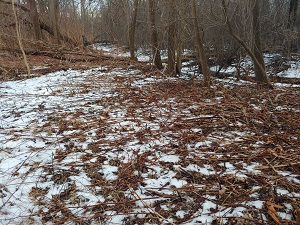 |
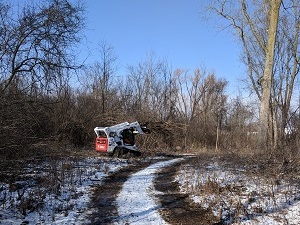 |
| Rotary Park - Japanese Knotweed removal | Rotary Park - Buckthorn removal |
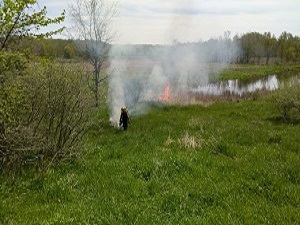 |
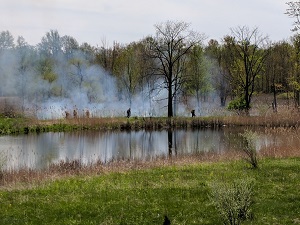 |
| Controlled burns at Lakeshore Park to control phragmities | |
Common Offenders
There are many invasive plant species found throughout Michigan. Informed property owners and citizens can do a lot in the battle against these plant bullies. Here are a few of the biggest offenders that can be found in and around the City of Novi.
Purple Loosestrife
Also known as the "purple plague," purple loosestrife (Lythrum salicaria) is an ornamental plant known for its purple-spiked flowers. Once limited to gardens in the Northeast, it now chokes wetlands across the country.
Common Reed
Common Reed (Phragmites australis) is a widespread and aggressive invasive species. The plant is common throughout Michigan in roadside ditches, along shorelines and within wetland areas. It quickly colonizes on sites where the soil has been disturbed and moisture is present. Able to easily grow to 12’ in height, this invasive spreads through both seeds and under ground roots (rhizomes). Phragmites is one of the most common invasive plant species within the City of Novi.
Tree of Heaven
Also known as Stinking Sumac, the Tree of Heaven (Ailanthus altissima) is a rapidly growing deciduous tree with pale gray bark, light brown twigs and large compound leaves. It can flourish in unfavorable conditions with little care, and was a common stock in nurseries across the country as early as the 1840s. Today it has become an out of control invasive, complete with spiked thorns.
Multiflora Rose
Multiflora rose (Rosa multiflora), also called rambler rose, is a thorny, perennial shrub with clusters of fragrant white-to-pink flowers that bloom in May or June. Small, bright red rose hips develop during the summer. It is often found on the edges of farms and along highways.
English Ivy
English ivy (Hedera helix) is one of the most popular ground covers in North America. However, its potential for escape is notorious. In the Pacific Northwest, English ivy invades the forest floors. Its evergreen leaves smother other native forest plants by denying them light.
Garlic Mustard
Garlic Mustard (Alliaria petiolata (Bieb.) Cavara and Grande) is one of Novi’s more threatening invasive species. It is a biennial, a plant with a two-year life cycle, growing its first year as a seedling and rosette stage plant and flowering the subsequent year. It most often grows in the forest understory or along forest edges but is also able to invade undisturbed forest habitats. It tolerates low light levels and is adapted to take advantage of disturbed habitats such as trails, roadsides and areas where trees have been removed. Garlic mustard has no significant natural enemies in North America.
For more information and helpful links regarding Garlic Mustard and other invasive species please visit the Michigan State University Extension website by clicking on the link.
Oakland County Cooperative Invasive Species Management Area (OC CISMA)
The City of Novi is a member of the Oakland County Cooperative Invasive Species Management Area (OC CISMA), which is a group of Oakland County communities that work together to educate the public about the problems that invasive species cause, and also work to remove them in order to protect and restore natural environments. More information about OC CISMA, and invasive species and their control, can be found at their website at https://oaklandinvasivespecies.org/
Miscellaneous Environmental Resources
City of Novi Recycling and Household Hazardous Waste information
Mesothelioma Guide
![]() Alliance of Rouge Communities (ARC) Resource Recovery Guide (A Citizen's Guide for Recycling and Household Hazardous Waste Disposal)
Alliance of Rouge Communities (ARC) Resource Recovery Guide (A Citizen's Guide for Recycling and Household Hazardous Waste Disposal)
![]() Rouge River Watershed Goals Poster
Rouge River Watershed Goals Poster
![]() Acceptable Practices for Managing Livestock Along Lakes, Streams and Wetlands
Acceptable Practices for Managing Livestock Along Lakes, Streams and Wetlands
Tip Cards
![]() Fertilize Sparingly and Caringly
Fertilize Sparingly and Caringly
![]() Carefully Store and Dispose of Household Cleaners, Chemicals, and Oil
Carefully Store and Dispose of Household Cleaners, Chemicals, and Oil
![]() Help Keep Pollution Out of Storm Drains
Help Keep Pollution Out of Storm Drains
![]() Choose Earth Friendly Landscaping
Choose Earth Friendly Landscaping
Links
ARC - Alliance of Rouge Communities
CISMA - Oakland County Cooperative Invasive Species Management Area
EPA – Environmental Protection Agency
FOTR - Friends of the Rouge
HRWC – Huron River Watershed Council
SEMCOG – Southeast Michigan Council of Governments
SMLC – Southeast Michigan Land Conservancy
OCWRC – Oakland County Water Resources Commission (formerly OCDC – Oakland County Drain Commission)
WC DPW-ESG - Wayne County Department of Public Works - Environmental Services Group
Eating Fish from the Rouge River
Fish are part of a healthy diet. Most fish are safe to eat. But some fish have high amounts of chemicals in them. Eating some types of fish too often can cause health problems, especially for women and children. MORE





